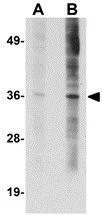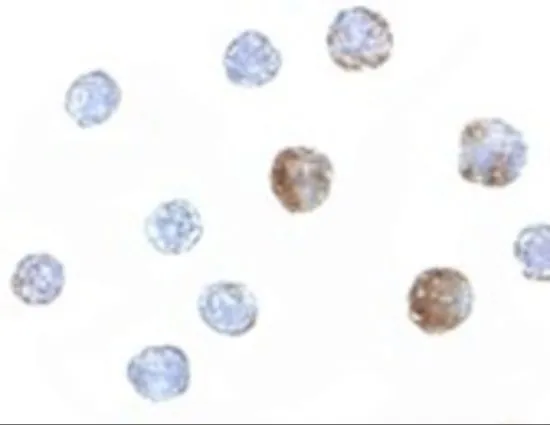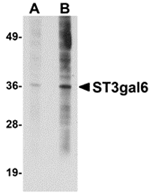
WB analysis of HeLa cell lysate using GTX85283 ST3gal6 antibody. Working concentration : (A) 1 and (B) 2 microg/ml
ST3gal6 antibody
GTX85283
ApplicationsImmunoFluorescence, Western Blot, ELISA, ImmunoCytoChemistry
Product group Antibodies
TargetST3GAL6
Overview
- SupplierGeneTex
- Product NameST3gal6 antibody
- Delivery Days Customer9
- Application Supplier NoteWB: 1 - 2 microg/mL. ICC/IF: 5 microg/mL. *Optimal dilutions/concentrations should be determined by the researcher.Not tested in other applications.
- ApplicationsImmunoFluorescence, Western Blot, ELISA, ImmunoCytoChemistry
- CertificationResearch Use Only
- ClonalityPolyclonal
- Concentration1 mg/ml
- ConjugateUnconjugated
- Gene ID10402
- Target nameST3GAL6
- Target descriptionST3 beta-galactoside alpha-2,3-sialyltransferase 6
- Target synonymsSIAT10, ST3GALVI, type 2 lactosamine alpha-2,3-sialyltransferase, CMP-NeuAc:beta-galactoside alpha-2,3-sialyltransferase VI, alpha2,3-sialyltransferase ST3Gal VI, sialyltransferase 10 (alpha-2,3-sialyltransferase VI)
- HostRabbit
- IsotypeIgG
- Protein IDQ9Y274
- Protein NameType 2 lactosamine alpha-2,3-sialyltransferase
- Scientific DescriptionSialyltransferases catalyze the transfer of sialic acid from cytidine 5-prime monophospho-N-acetylneuraminic acid (CMP-NeuAc) to terminal positions of glycoprotein and glycolipid carbohydrate groups. Terminal NeuAc residues are key determinants of carbohydrate structures, such as the sialyl-Lewis X determinants, and are widely distributed in many cell types. However, cancer cells often express more heavily sialylated glycans on their cell surface and this feature sometimes correlates with invasiveness. In contrast, expression of ST3gal6, a member of the sialyltransferase family that sialylates type II lactosamine structures on glycoproteins and glycolipids, was found to be significantly decreased by hypermethylation of the gene in gastrointestinal cancer. At least three isoforms of ST3gal6 are known to exist.
- Storage Instruction-20°C or -80°C,2°C to 8°C
- UNSPSC12352203





